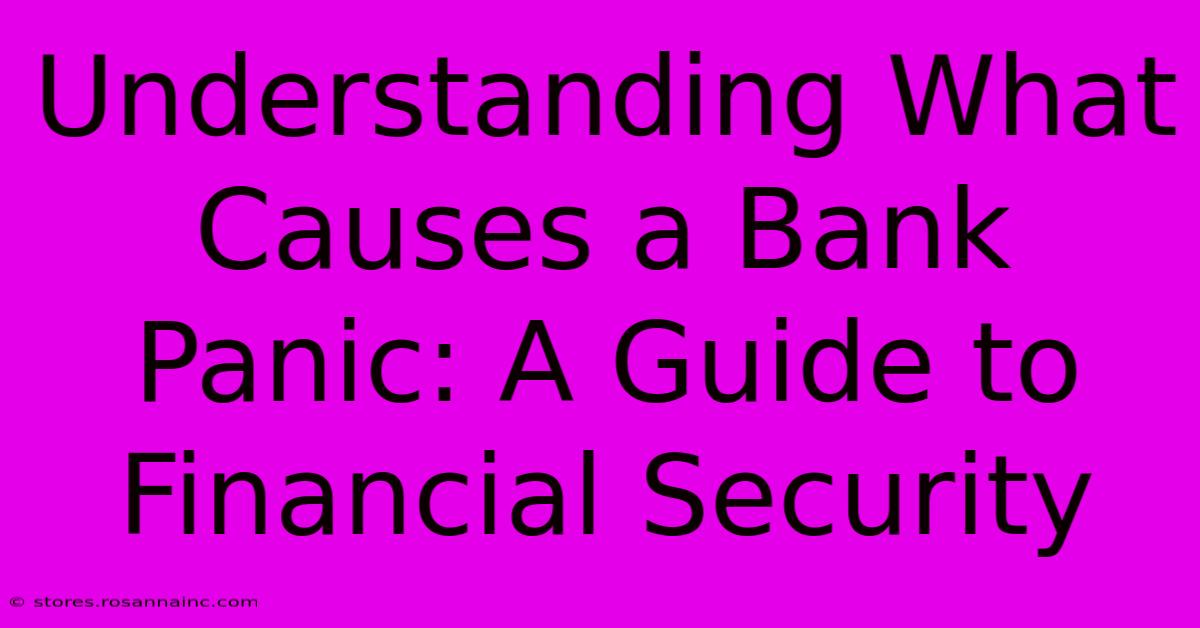Understanding What Causes A Bank Panic: A Guide To Financial Security

Table of Contents
Understanding What Causes a Bank Panic: A Guide to Financial Security
Bank panics. The very phrase evokes images of frantic crowds, long lines, and a crumbling financial system. While a full-blown panic is a relatively rare event, understanding their underlying causes is crucial for both individual financial security and broader economic stability. This guide will delve into the factors that trigger bank panics, exploring the psychology, economics, and regulatory aspects that contribute to these unsettling events.
What is a Bank Panic?
A bank panic, also known as a banking crisis or a run on banks, occurs when a significant number of depositors simultaneously attempt to withdraw their funds from a bank or a series of banks. This mass withdrawal is driven by fear – a fear that the bank is insolvent and will be unable to repay its depositors. This fear, once ignited, can quickly spread like wildfire, leading to a cascade effect where even healthy banks can become victims of the panic.
The Root Causes of Bank Panics: A Multifaceted Problem
Bank panics are rarely caused by a single event but rather a confluence of factors. Let's examine the key culprits:
1. Loss of Confidence and Rumours: The Psychology of Fear
The most crucial element in a bank panic is the loss of confidence in the banking system. This can stem from several sources:
- Economic downturns: Recessions or economic crises often trigger anxieties about job security and investment losses, leading depositors to seek the safety of their cash.
- Negative news and rumors: False or exaggerated reports about a bank's financial health can quickly spread, creating a self-fulfilling prophecy. Social media further amplifies this effect.
- Failures of other banks: When one bank fails, it can trigger a domino effect, as depositors in other banks fear a similar fate. This is often referred to as contagion.
2. Fractional Reserve Banking and Liquidity Issues: The Economics of Risk
The very nature of fractional reserve banking – where banks lend out a significant portion of their deposits – introduces inherent risk. If a large number of depositors demand their money simultaneously, the bank may not have sufficient liquid assets to meet those demands. This liquidity crunch can force the bank into insolvency.
3. Inadequate Regulation and Supervision: The Role of Governance
Weak regulatory frameworks and ineffective banking supervision can significantly increase the likelihood of bank panics. Insufficient capital requirements, lax lending standards, and a failure to address early warning signs can all create vulnerabilities within the banking system.
4. Asset Bubbles and Speculative Investments: The Dangers of Overconfidence
Periods of rapid credit expansion and asset bubbles (like the housing bubble preceding the 2008 financial crisis) can mask underlying vulnerabilities in the banking system. When these bubbles burst, the resulting losses can severely impair bank balance sheets, triggering a loss of confidence and fueling panic.
Protecting Yourself During Times of Uncertainty
While you can't control macroeconomic factors, you can take steps to enhance your personal financial security:
- Diversify your savings: Don't keep all your eggs in one basket. Spread your deposits across multiple banks, ideally those with strong financial ratings.
- Monitor your bank's financial health: Stay informed about your bank's performance and any potential risks.
- Understand your deposit insurance coverage: Familiarize yourself with the limits and conditions of your country's deposit insurance scheme.
- Maintain an emergency fund: Having readily accessible cash reserves can provide a buffer during times of economic uncertainty.
Conclusion: Understanding is the First Step to Security
Bank panics are complex events driven by a combination of psychological, economic, and regulatory factors. By understanding these underlying causes, individuals and policymakers can better prepare for and mitigate the risks associated with these potentially devastating crises. Staying informed, diversifying your savings, and maintaining a healthy emergency fund are critical steps in safeguarding your financial well-being.

Thank you for visiting our website wich cover about Understanding What Causes A Bank Panic: A Guide To Financial Security. We hope the information provided has been useful to you. Feel free to contact us if you have any questions or need further assistance. See you next time and dont miss to bookmark.
Featured Posts
-
91 Connect With India Effortlessly
Feb 09, 2025
-
Former Packers Db Coach Jauron Dies
Feb 09, 2025
-
What Time Is It In Nicaragua Find Out Instantly
Feb 09, 2025
-
Can You Help Save New York
Feb 09, 2025
-
7 6 Magnitude Earthquake Usgs Issues Tsunami Warning
Feb 09, 2025
